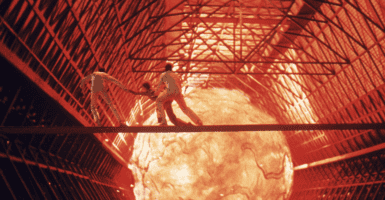Scientists Are Working On A Real X-Ray Vision Camera
Rather than using radiation to look directly through something like a traditional X-ray, these scientists are working on a way to use lasers to see around things.
This article is more than 2 years old

It can sometimes feel like research scientists are obsessed with science fiction ideas from the 1960s. After all, that seems like the only reason why there is a constant stream of developments in killer robots, killer robot dogs with guns, and trying to make Little Shop of Horrors into real-life. But sometimes scientists are actually trying to push technology forward in ways beneficial to humanity, like the ones who are working on developing real-world X-ray vision. While comic book advertisements from the past may make it seem like the only good reason to have X-ray vision is to be a creep in public, there actually are many good things that can be done. The researchers who published this piece in Nature Communications are doing just that.
To be fair, what they are working on is not exactly X-rays. Those work by producing electrons via a negatively charged electrode, which produces a massive amount of radiation energy, which is then directed at whatever body part you want to see inside of. We are all familiar with the basic premise of this from dental offices around the world.
Even more exciting than bombarding your teeth with a massive amount of radiation, these researchers are firing lasers of different frequencies. Cool, right? Basically, said lasers are shot at unseen targets, which bounce back and are superimposed to create a visual image. It’s related to a scientific technique known as interferometry, which is how we are able to measure the size and shape of far-away stars. So rather than attempting to see directly through something (like a traditional X-ray), these scientists are working on a way to use lasers to see around things.
So what can come of this, beyond the sheer human love of using lasers for literally any tasks? For one thing, this new imaging technique could theoretically allow vehicles moving in low visibility environments to actually see around corners or through fog and mist for safety. It could allow doctors to gaze into the human body and identify illnesses or malfunctions that do not involve bombarding said human body with X-ray radiation. It could even allow highly complex machines to be evaluated and checked out without having to dismantle them. It is a pretty cool deal, and it is nice for the forward progress of technology to not involve some variety of machine that will doubtlessly rise up against humanity at a future point.

Of course, as always, the real and improved X-ray vision camera is still in development. While the authors of the study have been finding vast leaps in the ability of cameras to take images of the unseen with their new technique, being able to see into the human body is still probably years away. So props to the world of the future for once actually working on something pretty cool, and that it also involves lasers. Because at the end of the day, isn’t using lasers the whole point of science? Well, probably not, but it is still pretty cool.












